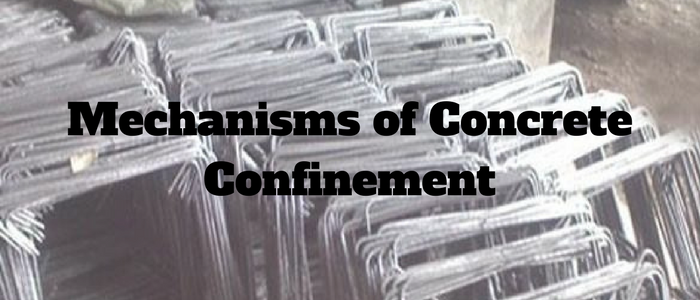Mechanisms of Concrete Confinement
Concrete under uniaxial compression tends to expand laterally and the longitudinal strains generated by such loading give rise to transverse tensile strains. which cause vertical cracking and failure in concrete. Lateral pressure that confines the concrete counteracts the lateral expansion, and results in a significant increase in ductility dong with the strength.
In practice, concrete is commonly confined by transverse reinforcement in the form of spirals or circular hoops or rectangular ties.
Sheikh (1978) has stated that if the concrete member is effectively confined, the core and the cover will respond differently under the application of axial load. At low level of longitudinal strains in concrete. the lateral expansion of concrete will be small; hence the lateral confinement provided by the transverse reinforcement will be negligible. As the longitudinal mains increase, the lateral strains of concrete also increase. The core concrete is restrained from expansion by the transverse reinforcement, resulting in the confinement of core and separation of the cover from the core. The cover concrete behaves as unconfined concrete and will become ineffective after the compressive strength is attained while the core concrete will continue to carry stress at high strains. After the cover spalls, the load carrying capacity of the concrete core will depend on the nature of confinement. Therefore, the compressive stress distributions for the core and cover concrete follow the confined and unconfined concrete stress-strain relations, respectively.
Effectiveness of confinement is dependent on the configuration of the lateral reinforcement. Confinement pressure exerted by spirals is different from that by rectangular ties. Circular spirals, due to their shape, are in axial hoop tension and provide a uniform confining pressure on the concrete core.
Therefore, circular hoops or spirals provide an efficient confinement of the concrete core. However, the confining pressure provided by ties is not uniform and depends on the restraining force developed in the hoop steel. The hoop steel develops hi& restraining forces at the corners where it is supported by longitudinal reinforcement, and low restraining action between the comers. This is because as concrete expands laterally under axial compression, the lateral concrete pressure tends to bend the sides of the ties outward due to their low stiffness and results in higher reactive pressures building up at the comers than at locations away from the corners. See Figure 1.

Read More

Comments are closed.